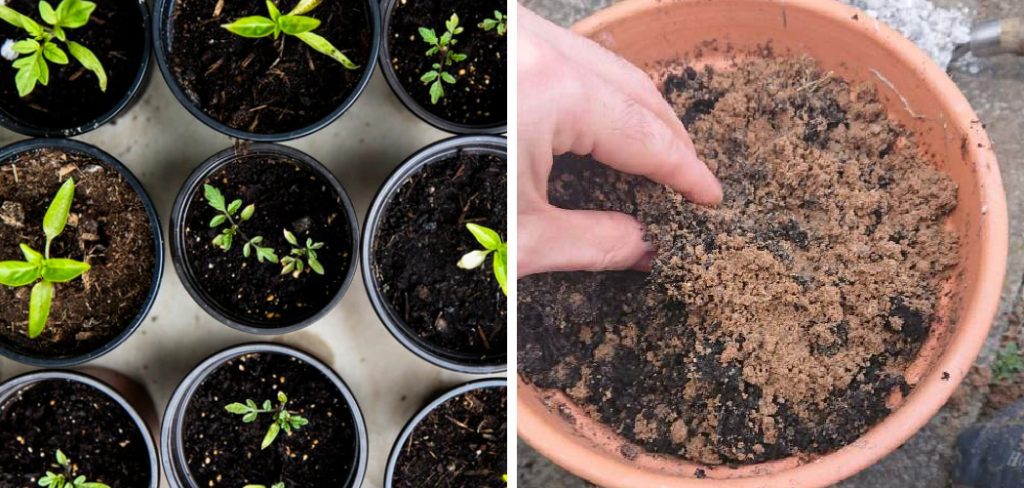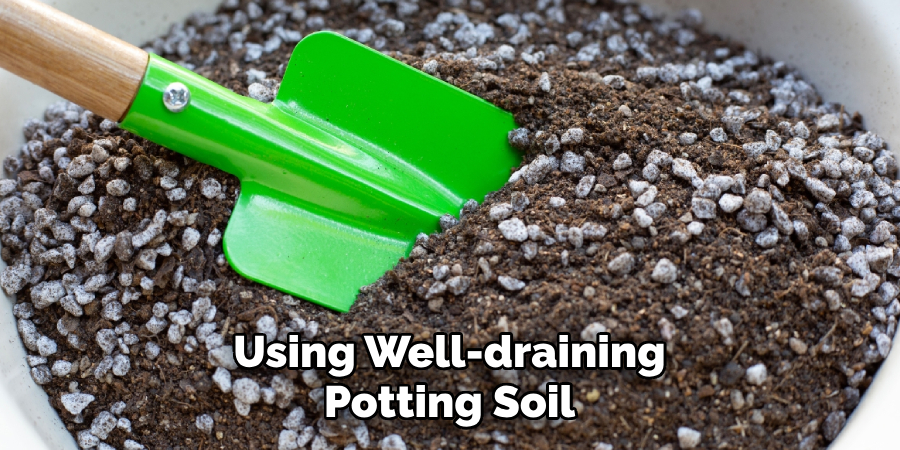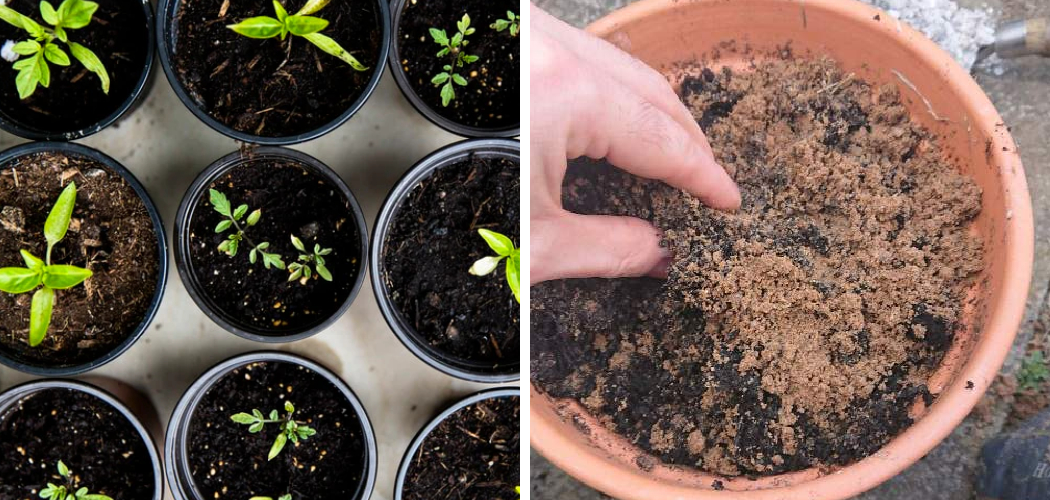To make potting soil for herbs, mix equal parts of compost, perlite, and coconut coir. A well-balanced potting soil provides the necessary nutrients and drainage for herbs to thrive.
In addition to these three main ingredients, you can also add small amounts of sand or vermiculite for improved drainage. Creating your own potting soil allows you to customize the mix to suit the specific needs of your herbs and ensure they receive optimal growing conditions.
With the right potting soil, your herb garden will flourish and yield a bountiful harvest of flavorful and aromatic herbs for culinary delights and medicinal purposes. So, let’s learn how to make potting soil for herbs and embark on a rewarding journey of growing your own herbs at home.

How to Make Potting Soil for Herbs: Step by Step Guide
Finding The Right Components For Homemade Potting Soil
When making potting soil for your herbs, it is crucial to find the right components. The ideal components will provide the necessary nutrients and drainage for healthy plant growth. Quality components in your potting soil make a significant difference in the overall success of your herbs.
Select ingredients such as peat moss, perlite, vermiculite, and compost for a well-balanced mixture. These components enhance the soil structure, retain moisture, and promote root development. Additionally, consider adding organic matter and natural fertilizers to further enrich the soil. By choosing the right components for your homemade potting soil, you ensure optimal conditions for your herbs to thrive.
So, invest in quality ingredients for a successful herb garden.
Essential Components For Making Potting Soil
Potting soil for herbs requires certain components to provide optimal growing conditions. Understanding the basics of these components is essential. One important element is organic matter, which adds nutrients to the soil. Compost is another crucial component as it improves soil structure and fertility.
Peat moss and coco coir increase moisture retention, benefiting herb growth. Perlite aids in soil drainage and aeration. Vermiculite, on the other hand, helps retain moisture. Adding sand to the mix can improve drainage, especially for herbs that prefer well-draining soil.
Lastly, soil amendments such as lime or sulfur adjust ph levels for specific herbs. By incorporating these components into your potting soil, you can create an ideal environment for your herb garden to flourish.
Creating Your Own Potting Soil Mix Recipe
Creating your own potting soil mix recipe involves designing a recipe for homemade potting soil. To determine the right proportions of components, consider the needs of your herbs. Adjusting ph levels in the potting soil is essential to ensure optimal growth and nutrient uptake.
Test the ph level and make necessary adjustments using materials like lime or sulfur. Furthermore, good drainage is crucial for the health of your plants. Adding perlite or coarse sand to the potting soil can improve drainage, preventing waterlogging. By following these guidelines, you can make high-quality potting soil for your herbs.
Process For Making Potting Soil
Making potting soil for herbs involves a step-by-step process that starts with gathering and measuring the components. Careful selection of ingredients is crucial for the quality of the final potting soil. Once the components are collected, they need to be mixed thoroughly to ensure an even distribution.
This will help provide the necessary nutrients, water retention, and drainage required for healthy herb growth. After mixing, it’s important to test the potting soil’s quality by observing its texture, moisture content, and overall suitability for the herbs you intend to grow.
Creating your own potting soil allows you to customize it according to the specific needs of your herbs, ensuring optimal growing conditions. Follow these steps to make nutrient-rich potting soil for successful herb cultivation.
Tips For Optimizing Potting Soil For Herbs
Creating customized potting soil for different types of herbs is essential for optimizing herb growth. Indoor herb gardens require special considerations, such as selecting the right ph levels for specific herbs. This ensures that the soil is suitable for their growth and nutrient absorption.
Adequate drainage is also crucial, as excess water can lead to root rot and hinder herb growth. By using well-draining potting soil and adding materials like perlite or sand, you can create an optimal growing environment. Remember to choose a potting mix with the right texture and composition to promote healthy root development.

Providing herbs with the ideal potting soil conditions will enhance their growth and ultimately improve your herb garden success.
Precautions And Best Practices For Potting Soil Making
Potting soil creation for herbs requires precautions and adhering to best practices to ensure safety and success. Proper handling safety measures and guidelines should be followed to protect yourself from harmful microorganisms. Additionally, understanding the proper storage techniques for potting soil is crucial.
This will help maintain its quality and prevent any potential contamination. To avoid contaminants in homemade potting soil, it is essential to follow guidelines and maintain cleanliness throughout the process. By taking these precautions and practicing the best methods, you can make potting soil for herbs effectively and without any risk to your health.
Maintaining And Reusing Potting Soil
Maintaining and reusing potting soil is essential for extending its lifespan. Regular potting soil maintenance is key to keeping it healthy. You can optimize used potting soil for future plantings by following a few simple tips. First, remove any plant debris or weeds from the soil.
Next, mix in fresh compost to replenish nutrients. It’s important to break up compacted soil and ensure good drainage by adding perlite or sand. Additionally, check the ph level of the soil and make any necessary adjustments. Remember to store your potting soil in a dry and cool place to prevent mold or pests.
By taking these steps, you can save money and promote sustainable gardening practices.
Frequently Asked Questions On How To Make Potting Soil For Herbs
How Do You Make Potting Soil For Herbs?
To make potting soil for herbs, mix equal parts of compost, vermiculite, and peat moss. This combination provides a well-draining and nutrient-rich soil for herbs to thrive. Make sure to sterilize the soil before planting to prevent any potential diseases or pests.
Can I Use Regular Soil For Growing Herbs?
It is not recommended to use regular soil for growing herbs as it may not provide the necessary nutrients and drainage that herbs require. Regular soil can compact easily and may not allow herbs to grow properly. Using a well-draining potting soil specifically formulated for herbs is the best option.
What Are The Essential Ingredients For Potting Soil?
Potting soil requires a mix of organic matter, such as compost or peat moss, a draining material like vermiculite or perlite, and a fertilizer to provide nutrients. These ingredients ensure the right balance of moisture, aeration, and nutrition necessary for plants to thrive in pots or containers.
Conclusion
Creating your own potting soil for herbs is a simple and rewarding process. By understanding the specific needs of your herbs and utilizing the right ingredients, you can ensure their growth and health. Remember to mix in well-draining materials like perlite or vermiculite to prevent waterlogged roots.
Adding compost or organic matter will introduce essential nutrients for your plants. Be careful with the ratio of ingredients, as too much of one can lead to imbalances in soil composition. Regularly monitoring and adjusting your potting soil as needed will allow for optimal plant growth.
Whether you’re an experienced gardener or a beginner, making your own potting soil will give you greater control over the quality and composition of the soil, leading to healthier and more flavorful herbs. Happy gardening!

